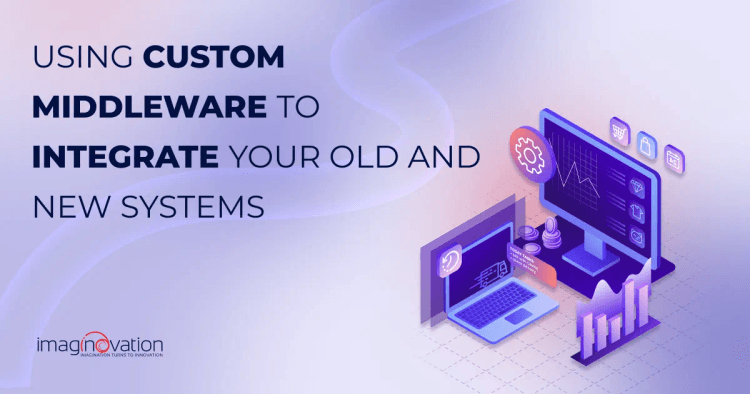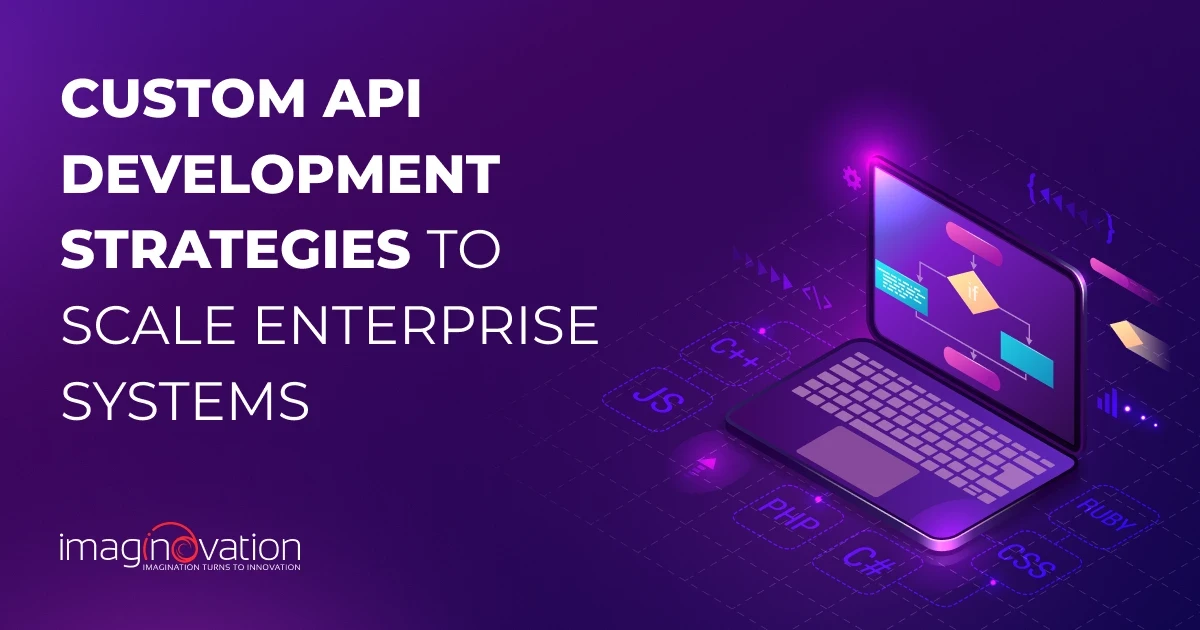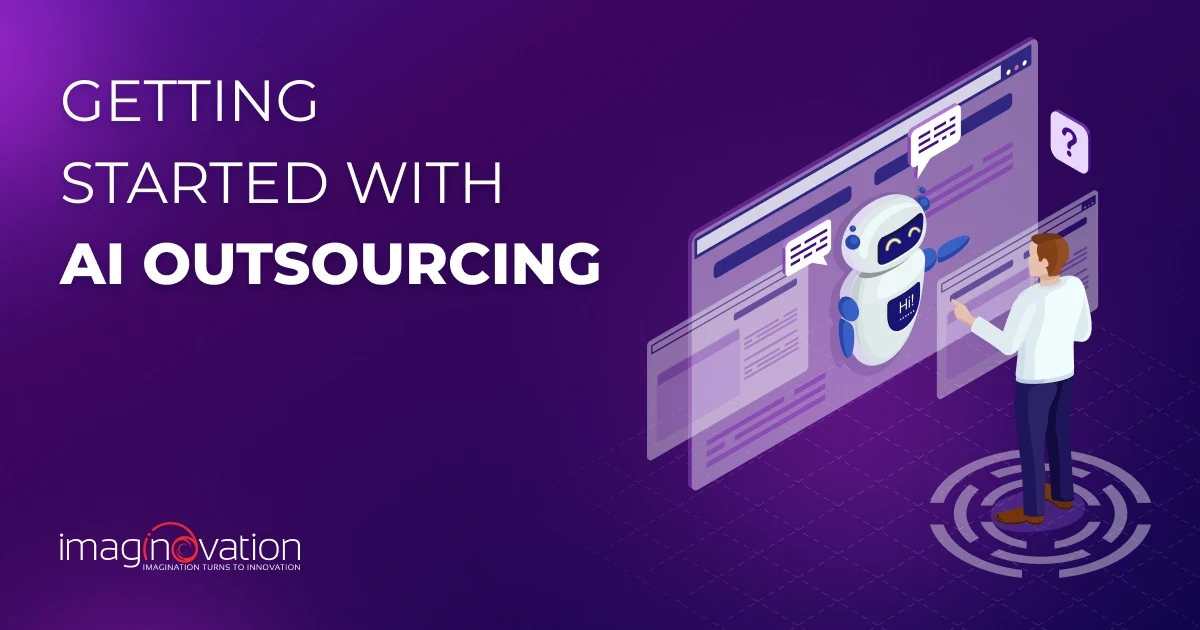Your legacy systems might still be getting the job done, but let’s be honest: are they really keeping pace with modern demands? Are they integrating easily with modern applications?
If your older systems struggle to integrate smoothly with modern applications, you're likely dealing with data silos, operational bottlenecks, and rising costs.
But ripping everything out to start fresh? That's expensive and disruptive.
There’s a smarter, simpler way—custom middleware.
Think of it as a bridge connecting your trusted legacy systems to new-age tech like AI, cloud, and automation tools.
In this guide, we explore how middleware can bring your systems together and modernize your business operations without turning your workflow upside down.
Let's start!
What is Middleware?
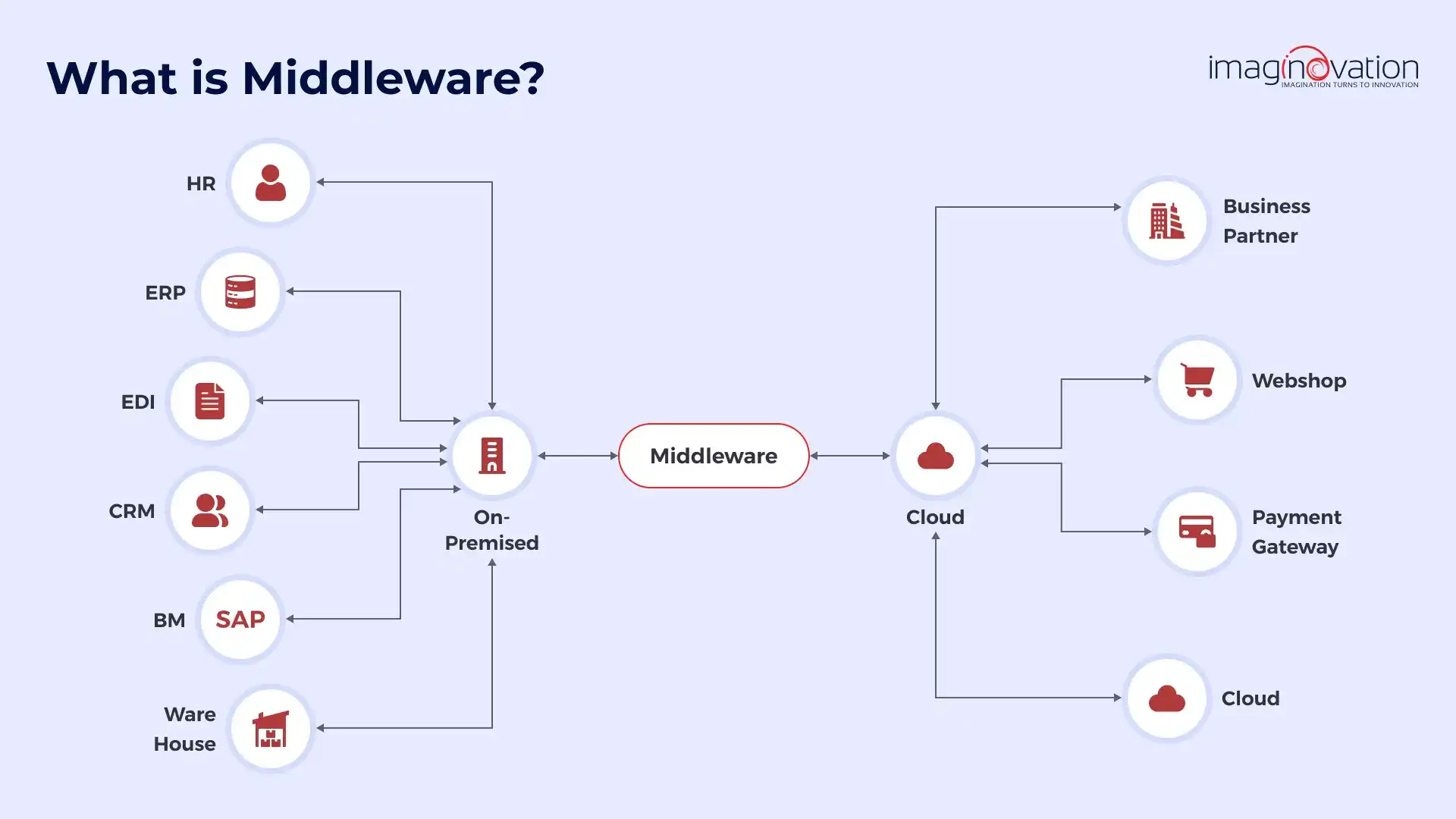
Let's say you have different applications or components, some new and some old. You are looking at connecting them to establish a connecting line with all these components in a distributed network.
You will love to have a "software glue" that can bind different systems together. This software glue (aka Middleware) helps to facilitate connections between platforms and is designed to connect all the components in the enterprise.
When you have developers build one that suits your business needs, you are looking at customized middleware.
Thus, middleware acts as a connector between different software systems, enabling them to communicate and exchange data.
Let’s look at the common types of middleware.
Common Types of Middleware
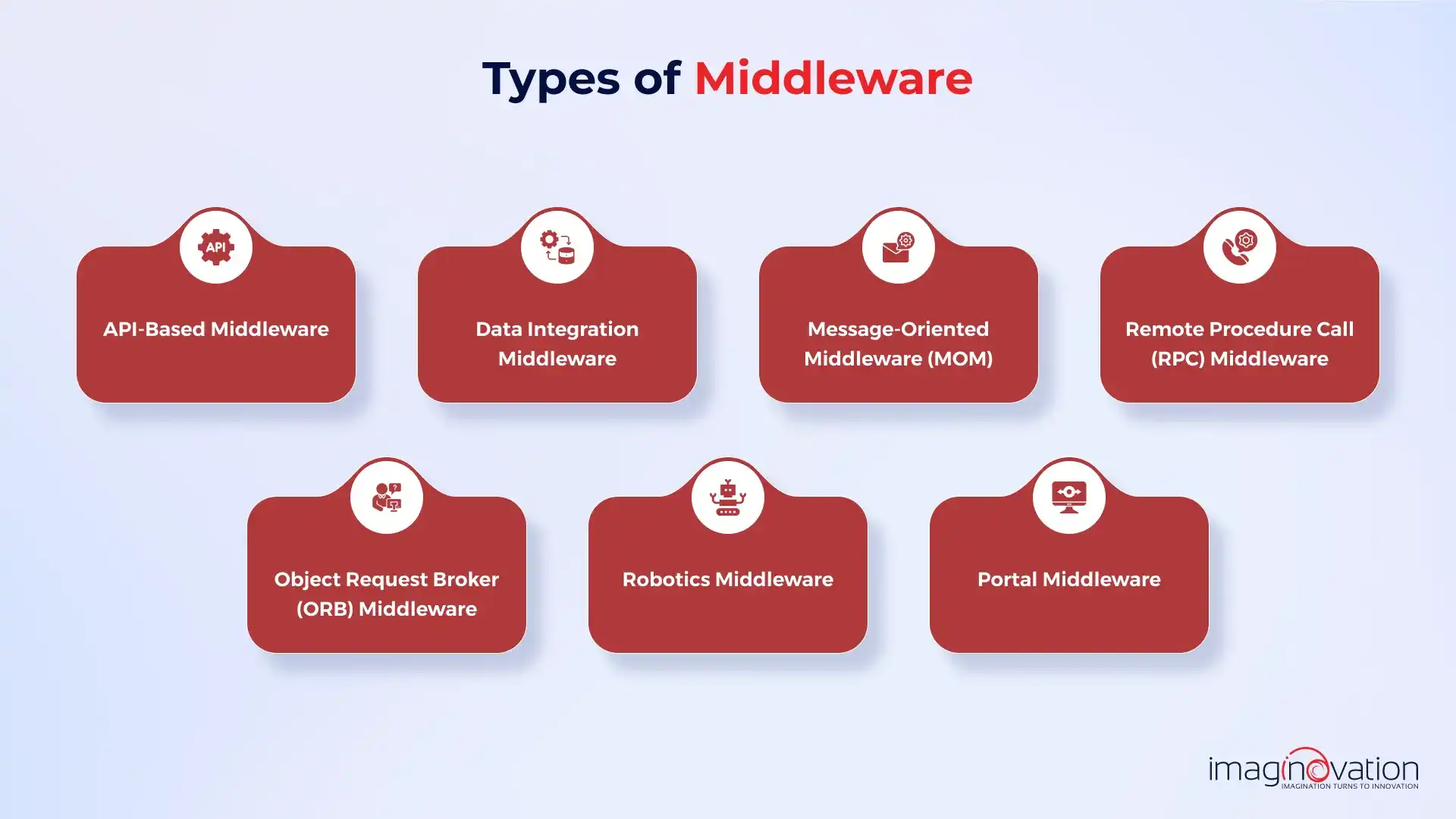
1. API-based middleware
Application Programming Interface or API middleware can assist your development team with myriad tools that can help manage, create, and expose APIs for applications.
APIs allow seamless connection between software systems through a standard layer of predefined interfaces.
2. Data integration middleware
Data or database middleware allows direct access to databases. It is designed to sync with databases, including Structured Query Language database software, offering multiple database gateways and options for connectivity.
3. Message-oriented middleware (MOM)
Message-oriented middleware (MOM) will help your team with a software infrastructure to facilitate the real-time data flow and exchange of messages between distributed systems or components.
MOM manages routing and delivery of messages and translates or transforms messages between applications.
4. Remote Procedure Call (RPC) middleware
RPC middleware offers a protocol allowing a program or application to request a service from another program located on a separate computer or network.
It is designed to perform both synchronous and asynchronous interactions between applications or systems.
5. Object Request Broker (ORB) middleware
ORB middleware is designed to manage communication requests from one application object or component and interact with a program, such as containers, across distributed systems.
6. Robotics middleware
Robotics middleware helps develop extensive software systems for robotics, integrating robotic hardware, firmware, and software from various manufacturers and locations.
7. Portal middleware
Portal middleware offers various tools and resources for integrating content from related applications.
Portals or enterprise portals are referred to as middleware and enable front-end integration and interaction between devices and back-end systems while creating a robust user experience.
Why is Middleware Essential for Integration?
Middleware is an essential part of integration.
Why?
Here's a quick peek.
1. Operational Efficiency
A key benefit of middleware is that it automates tasks and processes, which means that there is no need for manual intervention. The result is observed in your enterprise operations, which are faster and more accurate.
2. Bridging Legacy and Modern Systems
Remember we talked of "software glue (aka middleware)"; it can bridge your old legacy systems and new modern applications. Moreover, the good part is you will find no urgency in replacing the existing systems.
3. Reduced Operational Risks
You will experience fewer risks associated with unexpectedly shutting down legacy systems entirely before the new system is fully functional and validated.
4. Enhanced User Experience
Middleware facilitates a better user experience by integrating features from both system environments, giving users access to a coherent interface and improved functionalities.
5. Cost Efficiency
It can lead to cost savings by decreasing the need for specialized legacy system expertise, thus allowing companies to leverage a larger pool of developers skilled in more modern programming languages.
6. Faster Development and Deployment
Middleware can speed up the development process by providing existing solutions that can be customized rather than starting from scratch, thus shortening the integration time frame.
7. Flexibility and Scalability
The solutions can be designed to be flexible and adaptable to changing business needs, making it easier for organizations to scale their operations and technologies as required.
8. Scalable Solution
Moreover, the custom solutions have the flexibility to scale with your business, meeting the change in demand for data and operations.
9. Robust Security and Compliance
One of the key benefits you will enjoy is the diverse functionalities that range from encryption and authentication to role-based resource access. Moreover, you can also benefit from compliance features for specifications like GDPR and HIPAA.
Common Integration Challenges Middleware Can Solve

Reflect for a moment on these sentiments; do they sound familiar?
- “Our legacy system doesn’t support APIs. How do we connect it with modern applications?”
- “The third-party API has a rate limit. We keep hitting it and getting blocked.”
- “We need to ensure GDPR compliance before integrating with this platform.”
If these scenarios sound familiar, middleware can be a solution for all of them.
Let's check them out.
1. Legacy Systems Don’t Support Modern APIs
Your once-state-of-the-art legacy systems may still be mission-critical, but they likely don't support modern APIs.
Pete Peranzo, Co-founder of Imaginovation, emphasizes: "Sometimes there are old pieces that are just so mission-critical...no one really wants to touch them and...migrate them to the new modern solution."
How can you resolve such scenarios?
Pete suggests, "You can't just build something new when you have something that's been running for so many years...you’ve got to do it in a way that you have a bridge [middleware]."
Middleware serves as that bridge, enabling legacy systems—often incompatible with modern technology—to integrate with contemporary applications via APIs. This transition layer helps you with seamless communication and allows your business to modernize without entirely replacing critical systems.

2. Data Silos Slow Down Operations
Disconnected systems will not give you the complete picture, and it also slows down decision-making.
Further, you will find workflows disrupted, too. Middleware can help with real-time data synchronization across departments in all such scenarios. It will help boost efficiency and collaboration.
Let's look at an excellent example: a logistics company wanted to integrate HubSpot with their WMS (Warehouse Management System) and chose to use middleware as a solution. What resulted was enhanced order accuracy by a whopping 40%. Furthermore, the real-time data flow enabled individualized client assistance and faster sales cycles.
3. Security & Compliance Risks
Legacy systems may be running on old technology or architecture that may have security vulnerabilities. Middleware works as an excellent solution for implementing necessary security protocols.
Pete emphasizes, "As companies modernize their legacy systems, middleware plays a crucial role in adding security layers essential for meeting regulatory compliance such as HIPAA and GDPR."
He adds, "Transitioning to a new system via middleware not only improves efficiency but also allows companies to focus on embedding necessary security protocols for sensitive data."
For example, a U.S. federal agency was riddled with challenges due to aging midrange Solaris systems, and the team wanted to explore moving to cloud-based infrastructure.
The solution they worked out was collaborating with mLogica and Microsoft; with this, they could migrate their legacy Sybase ASE databases to Microsoft Azure. The steps helped them enhance performance, ensure security, and maintain compliance with federal regulations.
4. Scalability Issues
Pete rightly puts it, "Middleware is kind of a bridge... It's a path to get to where you're going without just jumping off the cliff." Thus, middleware acts as that glue [bridge] for your legacy on-premise systems with modern cloud applications.
When you explore the development aspect, you will find that middleware can support scaling your enterprise operations without overhauling your existing infrastructure.
It can further allow your business to integrate new functionalities and adapt to increased demands while relying on critical legacy systems.
5. Technology Incompatibility
You may have different applications, each developed in various programming languages and built on diverse software architectures. It could get complex in terms of communication and interoperability between these applications. Here's where middleware can come into the picture and serve as a vital intermediary layer.
Pete shares, "Sometimes you need to build it because the systems don't talk to each other... middleware can help in integrating tools that were built in different languages or architectures."
Thus, it works as a translator. It can support integration and data sharing among disparate systems while addressing technology incompatibility issues.
The open-source middleware technology Enduro/X is a significant real-world example since it enables distributed transaction processing and smooth integration across various computer languages, including C, C++, Go, Java, Python, PHP, and Perl.
Why Do You Need Custom Middleware?
When you start exploring possibilities around middleware, you will find off-the-shelf solutions.
If something is already available, do you still need a custom middleware?
Let's find out why off-the-shelf middleware solutions fall short.
Why Off-the-Shelf Middleware Solutions Fall Short
- Pre-built middleware doesn’t fully integrate with unique business workflows.
When you look at pre-built options, they are generic; logically, they will not fully align with specific processes. If you opt for such options, the downside is that you may still need an expensive customization.
For example, a global financial services firm faced transaction delays and compliance challenges due to the proper API structures in a pre-built middleware solution.
When the firm opted to develop a custom solution tailored to its operational needs, it benefited from improved performance, security, and regulatory compliance.
- Subscription-based middleware adds long-term costs without flexibility.
Enterprises have the option to go for subscription-based middleware. However, over time, they can become a financial burden and lock your business with ongoing costs on the one hand and no flexibility to scale or customize on the other.
Companies don't need to keep paying indefinitely for access. They can instead explore open-source alternatives or go for one-time licensing models and of course check out custom-built solutions that are made to fit business needs, offering more control and cost efficiency.
- Standard solutions lack customization for security, compliance, and AI-driven automation.
With growing security concerns, what do enterprises need today more than ever? Yes, you're right! They need solutions that meet ironclad security, compliance, and AI-driven automation requirements.
Frequently, typical middleware fails to map up to these requirements. Off-the-shelf solutions may lack specialized encryption and compliance features, exposing companies to security vulnerabilities.
In such circumstances, custom-built middleware provides compliance and operational efficiency while avoiding excessive long-term costs.
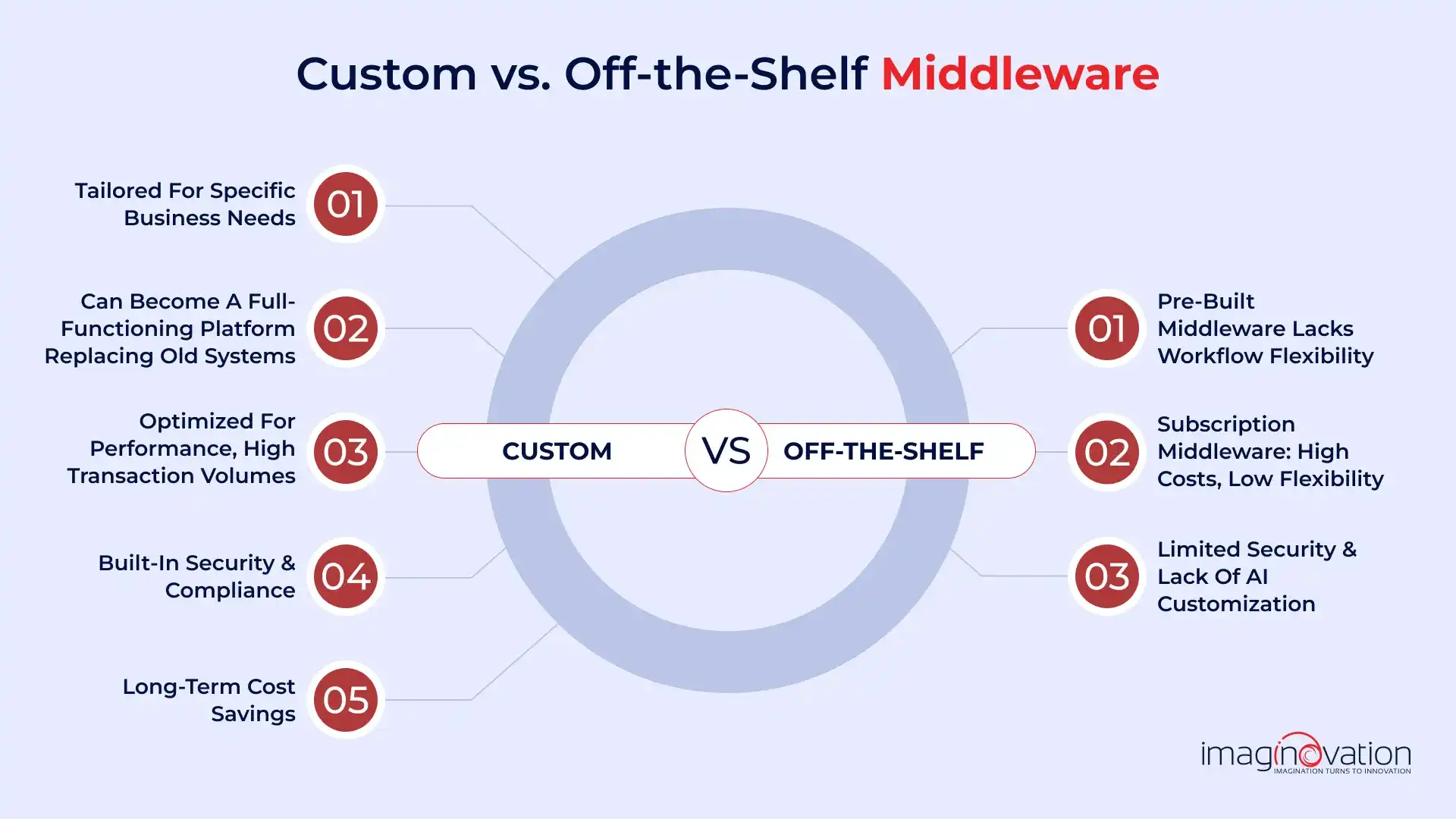
Benefits of Custom Middleware Development
- Middleware can become a full-functioning platform where companies can eliminate old systems.
As a business leader, if your outdated legacy systems are ringing concerns and you want to eliminate them, consider developing a custom middleware.
It will allow your enterprise to transform your integration layer into a full-functioning platform. Middleware evolves beyond its original role and becomes an operational system by centralizing data, automating processes, and ensuring seamless communication between applications.
The switch helps improve efficiency, scalability, and security while reducing maintenance costs. Moreover, it also provides a modern, future-proof foundation for business growth.
In this context, Pete shares his thoughts on the strategic use of custom middleware for a client of Imaginovation (Murgitroyd): "The middleware acts as a bridge, allowing us to operate our legacy system while we build a new one, minimizing disruption."
[Keep reading for a detailed case study of Murgitroyd]
- Tailored for specific business needs (vs. generic pre-packaged solutions).
Off-the-shelf solutions are limited in scope and don't address a particular business’s needs.
On the other hand, custom middleware outperforms and takes care of specific business needs with seamless integration, scalability, and optimized performance. Generic software is rigid, eliminating compatibility issues.
The solutions also enhance security and compliance and cater to necessary features. Sometimes, you may experience that off-the-shelf solutions have hidden costs and vendor dependencies.
Still, in contrast, custom middleware is cost-effective in the long run and offers complete control and a streamlined user experience.
- Optimized for performance & scalability, handling high transaction volumes.
When you consider developing a custom middleware, it is usually optimized for performance and scalability. You can enjoy seamless handling of high transaction volumes without bottlenecks with the solution. Unlike generic software, you will find that the solution can help you scale effortlessly while maintaining reliability and security.
An excellent real-life example is Uber's custom middleware, which has helped the organization handle millions of ride requests per second globally. Uber chose to build a highly scalable middleware layer even though there were lucrative off-the-shelf solutions.
The layer has helped optimize data processing, manage real-time location tracking, and ensure seamless communication between drivers and riders. The data processing manages real-time location tracking and ensures seamless communication between drivers and riders.
- Built-in security & compliance, ensuring safe integration with legacy systems.
Off-the-shelf solutions may offer generic security features that may sometimes not fit your business’s compliance needs. Thus, it is essential to build a custom middleware solution to ensure built-in security and compliance tailored to specific industry regulations (e.g., GDPR, HIPAA, PCI-DSS).
Those who opt for pre-packaged software may need additional workarounds or third-party tools to meet security standards. However, with custom middleware, you can easily integrate secure authentication, encryption, and access controls from the ground up, which reduces vulnerabilities.
- Long-term cost savings—avoiding high SaaS licensing fees.
An excellent advantage of investing in custom middleware development is that it can lead to significant long-term cost savings because there will be no need for expensive SaaS licensing fees.
On the flip side, with off-the-shelf SaaS solutions, you may have to shell out recurring subscription costs, user limitations, and inflexible pricing structures that quickly add up as your business scales.
Custom middleware gives you a tailored integration layer, which can help you connect with your existing systems efficiently. It also lessens reliance on third-party platforms while ensuring optimal performance and security.
How to Implement Custom Middleware for Seamless System Integration
When implementing custom middleware, there is a lot to learn from Richard Radic who served as the first Director of Engineering at Imaginovation. Richard made significant contributions to Murgitroyd (a client of Imaginovation) and Imaginovation's development and IT systems.
He was known for his work with older development languages and systems, having hands-on experience with technologies like COBOL and mainframe development, which were increasingly difficult to source expertise for as technology evolved.
He was a key figure in the company, and under his leadership Imaginovation could contribute to developing custom middleware and the ever-evolving technological landscape.
Let’s look at some key steps in implementing custom middleware.
Step 1: Assess Your Current IT Infrastructure
The first step in building custom middleware is closely examining your current IT setup. This means finding legacy system bottlenecks and integration challenges that might be causing problems and making it hard for different software to work together.
While checking the processes, it will help if you work on making a quick checklist of what can be automated. When you identify issues early, businesses can plan better.
Step 2: Choose the Right Middleware Architecture
Next, choose the most apt middleware architecture. How should you do that? A simple way will be to look at all the available options and select the one that aligns with your business needs.
Here's a small tip: if you integrate with cloud-based SaaS applications, cloud-based middleware will make an excellent choice for flexibility and scalability.
For large businesses with complex systems, an Enterprise Service Bus (ESB) is the ideal option for connecting various applications. It will also help to handle data flow more efficiently.
If your goal is to provide smooth connection across online services, API Gateway middleware offers secure and seamless interactions. Choosing the correct middleware leads to improved performance, quicker integration, and a more efficient IT ecosystem.
Step 3: Develop & Deploy Custom Middleware
Next, you can concentrate on developing APIs and connectors that will allow various systems in your business to communicate seamlessly. Security is critical because adding protective layers ensures compliance with industry requirements while keeping data secure.
In such instances, real-time monitoring and logging can help spot any concerns quickly. Consider working with a solution provider who can provide a well-designed middleware solution to improve efficiency, security, and operational visibility.
Step 4: Optimize, Scale, and Maintain
The final step is optimizing, scaling, and maintaining your middleware for long-term efficiency. Using AI-powered analytics, businesses can monitor performance and identify areas for improvement. As transaction volumes grow, scaling the middleware ensures smooth operations without slowdowns.
Continuous refinement and upgrades help keep the system compatible with new technologies and future integrations. By regularly improving middleware, businesses can maintain high performance, security, and adaptability in a constantly evolving digital landscape.
How Imaginovation Helped Clients with Custom Middleware Solutions
Let's look at an excellent example.
Case Study: Murgitroyd's (A client of Imaginovation) Middleware-Driven Transformation
Murgitroyd had a legacy system, and they were working on a system called Domino (similar to Lotus Notes). The system had become deeply embedded in their operations.
Over time, they realized that the system was serving well, but there was a scarcity of developers familiar with the outdated technology. As the system was mission-critical, Murgitroyd was actively seeking a solution so that they could benefit from a modern platform without disturbing their current operations.
The Solution
We developed a custom middleware solution to act as a bridge. It helped the team with seamless communication between their old and new systems. It worked on a two-step process; it allowed Murgitroyd to continue using key functionalities from Domino.
Later, the processes were gradually shifted to the new system. The overhaul to the new system took time, but the middleware could successfully absorb critical features and become the backbone of the new system. It helped Murgitroyd to retire their legacy technology with no disruptions after all necessary functions were fully operational in the modern platform.
The Bottom Line
Thus, middleware can evolve into a full-fledged platform, enabling companies to completely move away from legacy systems.
Wrapping Up
Opting for Custom Middleware requires meticulous planning so that your journey is flawless. You may be riddled with legacy-heavy and complex environments. Therefore, you must take steps to thoroughly assess your needs so that you can choose a development partner to ensure that you get the best solutions.
Ready to embark on your custom middle development journey? It's time to get ready to soar high and achieve long-term success.
Seamlessly Connect Old and New Systems with Custom Middleware
Bridge the gap between legacy and modern technology with top-notch custom middleware. Our team at Imaginovation are experts at developing game-changing digital solutions that can future-proof your business.
Ready to modernize?
Ready to build an app, but not sure where to start?
We've got you covered. Click the button below to get started.

